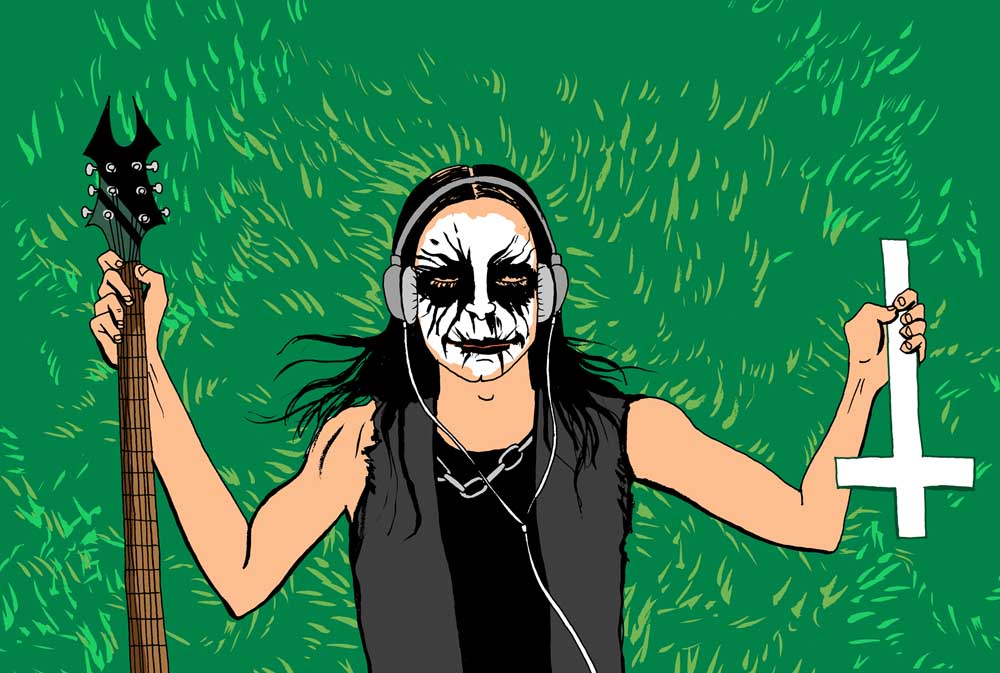Everything you ever wanted to know about black metal
Published 12:00 am Sunday, March 16, 2014

- Illustration by Danica Novgorodoff
“Black Metal: Evolution of the Cult” by Dayal Patterson (600 pgs., Feral House)
“The annals of Black Metal are fraught with violence,” intone Michael Moynihan and Didrik Søderlind at the beginning of their 1998 history “Lords of Chaos: The Bloody Rise of the Satanic Metal Underground,” “exploding in both self-administered suicidal shotgun blasts and cold-blooded, knife-blade murders. The number of deaths incurred worldwide is hard to calculate, but the frenzied nature of the killings bestows them with an unmistakable essence. As merciless as the murders have been, the ongoing campaign of church arsons adds psychological terror and religious intimidation to the list of Black Metal’s arsenal.”
This extraordinary passage raises troubling questions for music criticism, such as: Aren’t suicidal shotgun blasts self-administered by definition? Isn’t murder always merciless? What is the “list” of an “arsenal”? And most important: Why is this all the average music fan knows about black metal?
Well, I suppose Satanism, arson and murder are sort of attention-grabbing. And it wasn’t so long ago that I didn’t know Fenriz from a hole in the northern sky myself. My metal acumen extended to AC/DC, the first few Sabbath records, a little Slayer, and Appetite for Destruction. I was begging the local record store clerk to let me buy his advance copy of the new Pavement CD. Black metal seemed to be trying too hard — WE ARE SO EVIL, FOR REAL — while indie rock could barely get out of bed, which was more my speed.
But at some point, indie began to seem overly safe and insular. The world doesn’t need another article about how boring indie rock is, so I’ll just skip to the part where I heard Darkthrone’s Transilvanian Hunger for the first time. Then I’ll skip to the next day, when I heard it for the 10th time. Soon Emperor and Bathory and Immortal and other early black-metal bands began to infest my apartment with their brambly logos. Metal gave me a new lease on rock ’n’ roll, and it was black metal that set the paperwork in motion. Brothers and sisters, I am here to testify that pale, sickly beings once created a beautiful racket under the Scandinavian moon.
I often find myself called upon to explain the difference between black metal and death metal. As Dayal Patterson writes in his new book “Black Metal: Evolution of the Cult,” black metal features “high-paced percussion, high-pitched ‘screamed’ vocals, and fast tremolo picking on the guitars,” with an emphasis on “atmosphere,” while death metal emphasizes “brutality or technicality” and uses “‘growling’ vocals and frequent riff changes.”
Black metal’s sound is frequently described as “cold” and “icy,” in part because it draws its tropes from its Nordic origins — “At the Heart of Winter,” “Where Cold Winds Blow,” the grim reaper riding through snow-covered mountains. But it’s an effective descriptor, as well — guitars buzz and whine like industrial refrigerators, drums jackhammer, lyrics concern “sons of northern darkness under the throne of the moon” and are screamed by yetis.
With 600 pages of interviews and photographs documenting the genre’s birth and evolution, black metal is as definitive an encyclopedia of the music as the human race is likely to produce. Patterson seems to have spoken to every person who ever pondered the relationship of Satan to guitars in wintertime. Every aspect of black metal is allotted its 15 minutes of blasphemy: its roots in punk, thrash and death metal; its progenitors (Bathory, Mercyful Fate, Venom, Hellhammer, Celtic Frost); its early flowerings in Canada, Switzerland, Greece and the United States; its Cambrian explosion in Norway; its developments in France, Sweden, Poland and Japan; its snaking into increasingly unwieldy subgenres; its present-day “post-black-metal” incarnations.
It’s the Norwegian scene that receives the most attention, since Norway is black metal’s Liverpool, Memphis and New Orleans all in one, home to the bands that matter the most: Darkthrone, Mayhem, Burzum, Immortal, Emperor, Satyricon, Ulver, Gorgoroth, Enslaved. And, yes, some of the people in these bands burned down really gorgeous old churches and/or killed other people in these bands. Some of them killed people who weren’t in any band. Some of them killed themselves.
Patterson covers all this without resorting to sensationalism. It makes for queasily fascinating reading. Mayhem singer Per “Dead” Ohlin, who would shoot himself before he could appear on the group’s studio albums, auditioned by mailing the band a crucified mouse. “He had issues,” says Kjetil Manheim, the group’s drummer.
Mostly, Patterson just lets the band members talk, a strategy that has the fortunate effect of keeping his own prose to a minimum. But who cares? Fans aren’t looking for good writing from a book like black metal — they’re looking for lore, for new and eviler bands to listen to, for absurd statements from their metal gods. On that score, as your average metal reviewer might have it, it delivers the goods and then some.
Patterson’s authorial restraint is regrettable, though, in at least one respect. A minority of black-metal musicians are white-supremacist fools. Graveland’s Rob Darken, for instance, says “I am a warrior protecting traditional white man values.” And Patterson informs us that murderer Varg Vikernes, of Burzum, recently posted on his website about “Negroes and other inferior races” — which, according to Patterson, is “politically charged” speech.
This sort of nonsense should be countered with the mockery it deserves.
To be fair, Patterson does allow nonracist black-metallers to slam their idiot brethren, quoting, for example, Erik Danielsson, of the not exactly politically correct band Watain: “Black Metal is a cult of Satan, its foundation is the cultivation of Chaos and Darkness, and no little pimple-ridden Internet-nazi movement can change that.”






